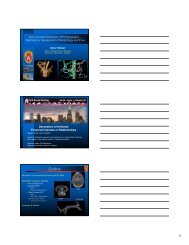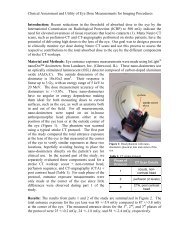(DBT) System
(DBT) System
(DBT) System
Create successful ePaper yourself
Turn your PDF publications into a flip-book with our unique Google optimized e-Paper software.
Facility Certification Extension<br />
Requirements, Quality Assurance<br />
and Medical Physicists’ role for<br />
Hologic Selenia Dimensions Digital<br />
Breast Tomosynthesis (<strong>DBT</strong>)<br />
<strong>System</strong><br />
Kish chakrabarti, Ph.D.<br />
Senior Physicist<br />
CDRH/FDA<br />
1
Digital Breast Tomosynthesis<br />
FDA approved the first <strong>DBT</strong> system in late<br />
2010<br />
Currently FDA allows use of <strong>DBT</strong> under<br />
MQSA through certificate extension process<br />
<strong>DBT</strong> can be installed only in already MQSA<br />
certified mammography facilities<br />
2
Certificate Extension I<br />
What is Certificate Extension?<br />
FDA’s Division of Mammography provide the<br />
Certificate Extension for a newly cleared<br />
/approved mammography system or a<br />
modality where no accreditation body is<br />
available<br />
Why does FDA give Certificate Extension ?<br />
FDA provides certificate extension to<br />
facilitate the use of a device which received<br />
marketing clearance or approval.<br />
3
Certificate Extension II<br />
Is Digital Breast Tomosynthesis (<strong>DBT</strong>) a new modality?<br />
<br />
<br />
Digital Breast Tomosynthesis is a new mammographic<br />
modality separate from Full Field Digital<br />
Mammography.<br />
In order to use the tomosynthesis portion of the unit,<br />
the facility must apply to FDA to have its certificate<br />
extended to include that portion of the unit. The<br />
certification extension only applies to the <strong>DBT</strong><br />
portion of the unit. The facility must have the 2D<br />
portion of the unit accredited by one of the<br />
accreditation bodies already approved to accredit the<br />
Hologic Selenia Dimensions 2D.<br />
4
MQSA statute requires that a facility can<br />
only be certified to perform mammography<br />
after it is being successfully accredited.<br />
In absence of an accreditation body for a<br />
new device or modality, FDA can thus only<br />
allow certificate extension to an already<br />
certified facility to add the new device.<br />
5
Certificate Extension III<br />
The main items that FDA reviews:<br />
<br />
<br />
<br />
Mammography Equipment Evaluation test<br />
results as per the manufacturer’s<br />
requirements<br />
A hard copy of a 3D phantom (image from a<br />
tomosynthesis slice will do)<br />
Lead Interpreting Physician Attestation to Staff<br />
Personnel Qualifications<br />
6
What does FDA review for Certificate<br />
Extension?<br />
For a complete requirement consult FDA’s<br />
website:<br />
MQSA Facility Certification Extension<br />
Requirements for Hologic Selenia Dimensions<br />
Digital Breast Tomosynthesis (<strong>DBT</strong>) <strong>System</strong><br />
http://www.fda.gov/Radiation-<br />
EmittingProducts/MammographyQualityStandards<br />
ActandProgram/FacilityCertificationandInspection/<br />
ucm243765.htm<br />
7
Important QC Tests:<br />
8
AEC Function Performance<br />
Corrected Pixel Value has to be in the range of<br />
the allowed values!<br />
9
Mammography vs. Tomosynthesis: Filter<br />
Tomosynthesis mode always uses Al filter!<br />
10
Mammography vs. Tomosynthesis:<br />
Resolution<br />
Mammo mode:<br />
Tomo mode:<br />
Resolution is lower for tomosynthesis images!<br />
11
Mammography vs. Tomosynthesis: Dose<br />
Average glandular dose must not exceed 300 mrad<br />
(3 mGy) for 4.2 cm effective breast thickness!<br />
12
“The doses for 2D and tomosynthesis are measured both in individual tests,<br />
and also together as part of the Combo procedure. It is not uncommon nor<br />
a defect for the doses to vary in the two modes, i.e. the tomosynthesis dose<br />
measured individually and as part of the Combo procedure can differ. The<br />
20 and tomosynthesis dose in the Combo mode are calibrated separately<br />
from the 20 and tomosynthesis dose calibrations used in the individual<br />
exposure modes and so will not be identical. Additionally, a site might<br />
have specifically requested that the doses be set differently in Combo<br />
compared to individual exposures such as might be desired for screening<br />
and diagnostic applications. The important point is that the doses in each<br />
mode (201 tomosynthesis Combo) each meet the specified pass/fail criteria.”<br />
13
Mammography vs. Tomosynthesis:<br />
Images<br />
Projection image: Reconstructed image:<br />
Objects have a shadow in reconstructed<br />
tomosynthesis images!<br />
14
Questions and Answers<br />
Can a facility perform patient imaging with <strong>DBT</strong> prior to FDA’s<br />
certificate extension approval?<br />
a. yes<br />
b. no<br />
c. yes, if application training is performed<br />
d. yes, if a written guarantee of the quality is provided to the patient<br />
e. yes, if a verbal OK is obtained from CDRH<br />
Answer: b<br />
Ref: MQSA Facility Certification Extension Requirements for<br />
Hologic Selenia Dimensions Digital Breast Tomosynthesis<br />
(<strong>DBT</strong>) <strong>System</strong><br />
http://www.fda.gov/Radiation-<br />
EmittingProducts/MammographyQualityStandardsActandProgram/<br />
FacilityCertificationandInspection/ucm243765.htm<br />
15
Questions and Answers<br />
2. Who can perform <strong>DBT</strong> equipment evaluation after the<br />
machine installation ?<br />
a. service engineer<br />
b. rad tech<br />
c. qualified medical physicist only<br />
d. rad tech or a medical physicist<br />
e. rad tech or a radiologist in consultation with a off site<br />
physicist<br />
Answer: c<br />
Ref:MQSA Facility Certification Extension Requirements<br />
for Hologic Selenia Dimensions Digital Breast<br />
Tomosynthesis (<strong>DBT</strong>) <strong>System</strong><br />
http://www.fda.gov/Radiation-<br />
EmittingProducts/MammographyQualityStandardsActandPro<br />
gram/FacilityCertificationandInspection/ucm243765.htm<br />
16
Questions and Answers<br />
3. What are the important <strong>DBT</strong> MEE test results that FDA looks at<br />
as a part of <strong>DBT</strong> certificate extension process?<br />
a. collimation and dose results<br />
b. phantom image and monitor QC result<br />
c. resolution, AEC performance, dose and phantom image<br />
d. dynamic range, CNR, SNR and uniformity<br />
e. printer QC, monitor QC, dose and phantom image<br />
Answer: c<br />
Ref: MQSA Facility Certification Extension Requirements for<br />
Hologic Selenia Dimensions Digital Breast<br />
Tomosynthesis (<strong>DBT</strong>) <strong>System</strong><br />
http://www.fda.gov/Radiation-<br />
EmittingProducts/MammographyQualityStandardsActandProgra<br />
m/FacilityCertificationandInspection/ucm243765.htm<br />
And Hologic Selenia Dimension QC Manual Revision 003<br />
17






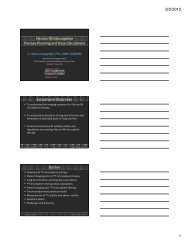


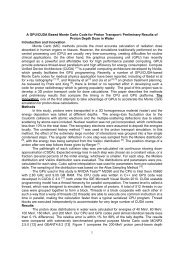
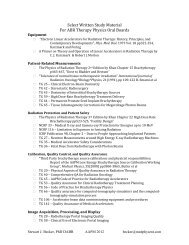
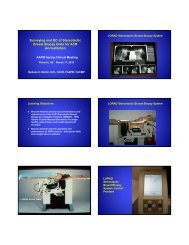
![SBRT&StereoscopicIGRT_2012 [Compatibility Mode]](https://img.yumpu.com/16889220/1/184x260/sbrtstereoscopicigrt-2012-compatibility-mode.jpg?quality=85)

